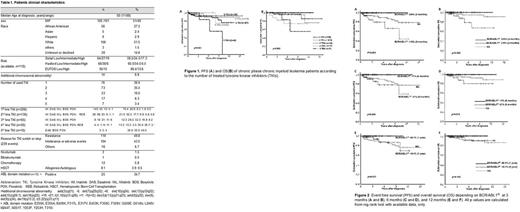Abstract
Introduction: Tyrosine kinase inhibitors (TKIs) made great success in chronic myeloid leukemia (CML) treatment. However, TKIs often need to be changed due to not only adverse events but also suboptimal response or treatment failure. Currently, 5 TKIs, imatinib (IM), dasatinib (DAS), nilotinib (NIL), bosutinib (BOS), and ponatinib (PON) are approved for CML, and the sequential TKI treatment outcomes has not been well studied. Thus, we sought to evaluate outcomes of CP CML in an era where several TKIs are available.
Method: Record of CP-CML who were referred to Winship Cancer Center between January 2005 and April 2016 were reviewed. We excluded patients who did not initiate TKI as first-line within 6 months after diagnosis.
Results: A total 206 patients were included and followed up median 48.8 (1.4-190.1) months. Clinical characteristics were summarized in table 1. Age at diagnosis was 50 (11-88), and male/female was 105/101. Risk scores was calculated in 110 patients (53.4%), and low/(intermediate)/high of Sokal, Hasford, and EUTOS were 64/27/19, 66/38/6, and 95/15, respectively. Four-teen patients (6.8%) showed additional chromosomal abnormality at initial diagnosis. A total 76 patients (36.9%) were treated with one TKI, 73 (35.4%) were 2 TKIs and rest of them (27.7%), more than 3 TKIs (3 TKIs, n=33; 4 TKIs, n=17; 5 TKIs, n=7). Eight-teen patients (8.7%) reused same TKIs in different treatment lines. IM was the most frequently used in 1st line treatment (n=145, 70.4%), DAS in 2nd line treatment (n=68, 52.3%), NIL in 3rd line treatment (n=21, 32.3%), and PON in 4th and 5th line treatment (n=11, 36.7%, and n=4, 40%), respectively. Reason for switching TKIs or discontinuation included resistant (49.8%), intolerance or adverse event (43.5%), and others (insurance, clinical trial, or reason are not available, 6.7%). ABL domain mutation were tested in 71 (34%) patients, and mutations were detected in 25 patients (35%). Nine patients had more than one mutation, and T315I were detected in 36% of them (n=9).
Median 39.0 (3.8-119.8) months after diagnosis, 19 (9.2%) were progressed to advanced phase (AP, n=6; myeloid BC (MBP), n=4; lymphoid BP (LBP), n=9). Eight patients underwent allogeneic HSCT due to TKI failure (n=2), presence of T315I mutation (n=1), persistent neutropenia after imatinib (n=1), and progression to LBP (n=3) and AP (n=1), and 1 did autologous HSCT due to progression to MBP with CSF involvement. Ten patients were expired because of complication of allogenic HSCT (n=3), refractory disease (n=6) and acute myocardial infarction (n=1).
Estimated cumulative PFS at 5- and 10-year were 92% and 81%, and OS at 5- and 10-year were 94% and 87% respectively. Fifteen patients of progressed patients were treated with median 1.5 (1-3) more TKIs after disease progression, number of used TKIs for PFS and for OS are not same. According to number of used TKI, PFS rates were not different between groups (Figure 1A, p=0.051), but OS rate were different (Figure 1B, p=0.002). OS at 10 years of 1 TKI was 100% (n=76), 2TKI, 82% (n=73), 3TKIs, 87% (n=33), 4 TKIs, 75% (n=16), and 5TKIs, 55% (n=7), respectively. In univariate analysis, female (p=0.008), ABL kinase mutation (p<0.001), optimal response at 3, 6, and 12 months were related PFS (p<0.001, p=0.002, and 0.037, respectively) (Figure 2 A, C, and E), and Hasford (p<0.001), EUTOS (p=0.047), optimal response at 3 and 6 months (p=0.002 and 0.013) predicted OS. (Figure 2 B and D). Age, race, Sokal score, additional chromosomal abnormality, and 1st line TKI (IM vs newer generation TKIs) did affect neither PFS nor OS.
Conclusion: In the era of multiple TKIs, 63% of CP-CML patients were treated more than one TKIs. The best OS was observed in patients tolerating and responding to first and second-line TKI, but OS of 5 TKIs treated patients at 10 years were still 55%, showing potential for long term survival. PFS and OS can be predicted by early molecular response.
No relevant conflicts of interest to declare.
Author notes
Asterisk with author names denotes non-ASH members.


